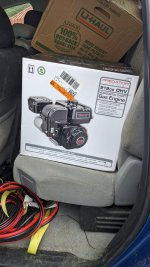SpeedPagan
The iRacing Guru
- Joined
- Sep 29, 2009
- Messages
- 19,354
- Points
- 1,033
Background:
Back in the 90s, my brother actually raced flat-karts in the Southeast USA, and he was good enough to win track championships and won state championship in Virginia, USA. I'll be honest, as a kid I wasn't mature enough like my brother to really understand or know how to race. My brother hung up his helmet when he started college and I've been sim racing on everything from NR2003, ARCA Sim, to iRacing.
I recently sold my business that I built up over the last 14 years and when I was running the business, I didn't really have time, or energy, to devote to any hobbies really. However, now that I'm moving to a typical M-F 9-5 job, I have a lot more time on my hand than I did when I ran my business. I'm 40 (actually 39, but for the sake of simplicity let's say 40) now and I want to get into racing go-karts as a hobby.
What I'm looking for:
First off I should mention that I'm looking for something in dirt oval karting.
I live in North Carolina, not too far from Charlotte and it's a pretty good area for people like me. I was going to race at a track in someone's backyard because the track was a private karting club ($25 per race) and the owners of the track did a really good job of keeping the monetary arm's race out of the track. Which is what I was looking for. However, I recently got word that the owners is shutting down for the rest of 2023 and from the Facebook post, I'm not holding my breath for them to re-open in 2024.
Even though the karting club I was going to race at has now shut down, I still want to race. However, I honestly don't have the money to sink into getting into a monetary arm's race with everyone else in the pit area. Which is why I'm hoping to stick to a Predator Box Stock class where hopefully the cost is kept at a manageable level. Where the racing is more about driver's ability and chassis set-up rather than who can outspend who.
I realize I'm probably looking for a pipe dream, but I'd still like to find something as close to it as I can get. Like I said, this is a hobby, I have no delusion about getting into CARS Tour, or the Craftsman Truck Series. It's something for me to do at night in my garage and on the weekends during racing season.
If anyone can point me in the right direction, I would be very grateful.
Thank you and I hope y'all have a great day.
Back in the 90s, my brother actually raced flat-karts in the Southeast USA, and he was good enough to win track championships and won state championship in Virginia, USA. I'll be honest, as a kid I wasn't mature enough like my brother to really understand or know how to race. My brother hung up his helmet when he started college and I've been sim racing on everything from NR2003, ARCA Sim, to iRacing.
I recently sold my business that I built up over the last 14 years and when I was running the business, I didn't really have time, or energy, to devote to any hobbies really. However, now that I'm moving to a typical M-F 9-5 job, I have a lot more time on my hand than I did when I ran my business. I'm 40 (actually 39, but for the sake of simplicity let's say 40) now and I want to get into racing go-karts as a hobby.
What I'm looking for:
First off I should mention that I'm looking for something in dirt oval karting.
I live in North Carolina, not too far from Charlotte and it's a pretty good area for people like me. I was going to race at a track in someone's backyard because the track was a private karting club ($25 per race) and the owners of the track did a really good job of keeping the monetary arm's race out of the track. Which is what I was looking for. However, I recently got word that the owners is shutting down for the rest of 2023 and from the Facebook post, I'm not holding my breath for them to re-open in 2024.
Even though the karting club I was going to race at has now shut down, I still want to race. However, I honestly don't have the money to sink into getting into a monetary arm's race with everyone else in the pit area. Which is why I'm hoping to stick to a Predator Box Stock class where hopefully the cost is kept at a manageable level. Where the racing is more about driver's ability and chassis set-up rather than who can outspend who.
I realize I'm probably looking for a pipe dream, but I'd still like to find something as close to it as I can get. Like I said, this is a hobby, I have no delusion about getting into CARS Tour, or the Craftsman Truck Series. It's something for me to do at night in my garage and on the weekends during racing season.
If anyone can point me in the right direction, I would be very grateful.
Thank you and I hope y'all have a great day.



